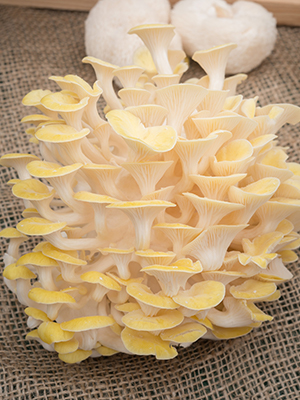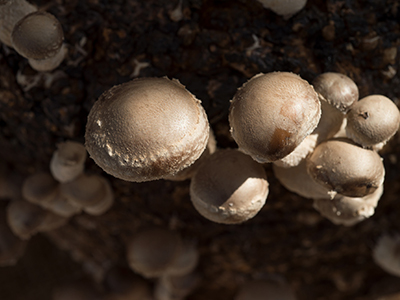Growing Mushrooms at Home

Oyster mushrooms come in several colors, like yellow. USDA photo by Lance Cheung.
For mushroom lovers, the idea of growing these fabulous fungi at home can be exciting and intimidating. Shiitake mushrooms and oyster mushrooms are two great types for the beginning home mushroom grower to try. Shiitake mushrooms, while often found in stores, are much cheaper to grow at home. Oyster mushrooms are less common in stores because of their delicate, hard-to-ship nature.
Purchasing a mushroom cultivation kit is the easiest way to start growing your own mushrooms at home. Oyster mushrooms (Pleurotus ostreatus) or Shiitake mushrooms (Lentinula edodes) are great choices for first timers because they are delicious and are some of the easiest to grow.
How you grow your mushrooms will depend on the kit you buy. But don’t worry; they should come with instructions to help you get started.
A little about mushrooms
The parts of the mushrooms that we eat are actually the fruiting (reproductive) bodies of fungi. Growing mushrooms is quite different from growing plants. Since mushrooms are not capable of photosynthesis and producing their own food like plants, mushrooms depend on a substrate, material on which the mushrooms grow. Logs, straw, or other cellulose sources are some examples. The mushrooms take nutrients from the substrate as it decomposes. Growing mushrooms indoors is generally preferred since it will provide you more continuous and predictable fruiting.
Oyster Mushrooms
Oyster mushrooms are delicate, with a flavor that is milder than Shiitakes. You aren’t likely to see these in stores simply because they don’t ship well. Colors will vary with the different strains but you can have oyster mushrooms that are tan, cream, grey, pink, or yellow.
Generally, oyster mushroom growing kits will come with a mass of sticky white mycelium (the thread-like, non-reproductive starter part of mushrooms) that has colonized a tower of straw inside of a perforated plastic bag. After soaking, mushrooms will form on the outside and should be ready for harvest in just about a month.
Shiitake Mushrooms
Shiitake mushrooms have a full, smoky flavor and a dense texture that holds up well for cooking. They're easily found in stores, but you can likely grow them much more inexpensively at home. Growing Shiitakes at home is rewarding. It might take a bit of time to get started, but once you’re going they can produce sporadic flushes. Choosing your substrate is a very important part of growing Shiitake mushrooms. If growing on hardwood logs, Shiitakes can be produced for 3 to 5 years once the wood has been inoculated with mushroom spawn.

Shiitake mushrooms growing on a log substrate. USDA photo by Lance Cheung.
Once you get the hang of growing mushrooms you can try your hand at purchasing spawn that will grow on other materials, such as sawdust and even shredded paper. You may even want to try some different—and potentially more challenging—mushroom types like chanterelle (Chantharellus cibarius), “yellow” morel (Morchella esculenta), and field mushrooms (Agaricus campestris).
For more information on growing your own mushrooms, contact your local County Extension Office.
Also on Gardening Solutions
More from UF/IFAS
- DIY FunGuide: Grow Your Own Oyster Mushrooms at Home
- Gardening in the Panhandle: Grow Shiitake Mushrooms in Your Backyard
- Gardening in the Panhandle: Oyster Mushrooms Can be Grown at Home
- Isolation of Mother Cultures and Preparation of Spawn for Oyster Mushroom Cultivation
- Mushroom—Agaricus bisporus (Lge.) Sing.
- The Pecan Truffle (Tuber lyonii): A Gourmet Truffle Native to the Southeastern US

